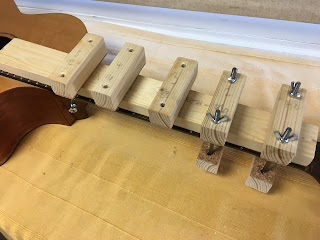This is a much more complex project than anything I've tried so far, but I have a high expectation for it. The aim is to spend less than £100 on materials for the conversion but end up with an instrument to be proud of.
I wouldn't even be considering this project if it wasn't for the fact that Faith guitars use a bolt-on neck so, in theory, it should be relatively easy to remove it and use as a pattern for the replacement bouzouki style neck.
First step is to remove the strings and pegs and everything from the neck area: machine heads, nut, truss rod cover & strap button. This picture shows that the back of the head has actually been battered around a fair bit and also shows up how rough my original repair was. It just instictively feels so weak.
Then back into familiar territory by now, getting the steam iron out again to steam the fingerboard off. People at work are starting to wonder why I have mahogany coloured stripes down my shirts......
It actually put up quite a fight compared to last time, so I can take comfort that my gluing was strong 😀
This inside shot shows the 2 bolts that hold the neck on. They are hidden behind a sticker that Faith put on in the factory.
With the fingerboard off, and the bolts removed, the neck could move a little but wasn't breaking free. It looked like there was maybe a bit of glue from the fingerboard holding this extension piece in place. I scored through it carefully with a Stanley knife.
"𝅘𝅥𝅮𝅘𝅥𝅮𝅘𝅥𝅮 I want to break free ee... 𝅘𝅥𝅮𝅘𝅥𝅮𝅘𝅥𝅮 " Gently does it....
Once apart, you can see the mortice and tenon joint and also the two inserts in the neck which the bolts screw into.
A small piece of the soundboard broke away with the fingerboard (another lesson learned there). It glued back in OK though.
The inserts unscrewed easily from the neck using a hex key, so I can reuse these on the new neck.
All of the preceding photos were taken at very careful angles to not show the fact that as soon as I started to take the fingerboard off, the neck joint snapped again!! I was right when I said that it just instictively felt so weak.
So now onto making the new neck next. I have several sources showing me the theory of what I need to do and it all looks relatively achievable. We shall see.











































































